|
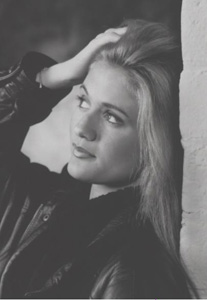 Cyber-Interview of
the Month: Cyber-Interview of
the Month:
Brett McNichols
-by Manny
Siverio
Originally published on SalsaNewYork on 7/02
This Month we interview NY Mambo Performer
and Instructor Brett McNichols.
Brett has been involved in one dance form or another since her childhood. In
the short amount of time she has been involved in the New York Dance Scene;
she has taught workshops in Washington-DC, performed in the West Coast Salsa
Congress, the East Coast Salsa Congress, 1st
Annual Zurick-Switzerland Salsa Kongress and the 1st Annual DR Salsa
Congress. Brett is currently a member of Addie
Diaz's Addie-tude Dance
Company. She has recently been added to SalsaNewYork's
Online Directory of On2 Instructors.
Cyber-Interview:
Brett McNichols
SNY:
How long have you been dancing mambo and what got you into it?
BM: Ive
been dancing mambo formally since December 1999 when I took my first class at
Dance Manhattan in NYC.
Before that I would dance mambo socially at nightclubs throughout the
city and Westchester, and at family parties. I always loved Latin music, but
the advanced dancers I would see in clubs throughout the city intimidated me.
I started going to Latin clubs back in like, 1994, and whenever the D.J.
would play Salsa, the dance floor would clear and only a few couples would
dance, and I would just stand there and watch... I was in awe of the beauty
and detail of mambo dancing.
That really made me determined to learn this form of dancing.
I was truly impressed by the intricate turn patterns and the rhythm of
the music. Little
by little, I would inch my way onto the dance floor and dance with whoever
would ask, and every time I would social dance, I would learn something new.
Then it got to the point where I felt frustrated with my stagnant level
of dancing, and decided it was time to enroll in dance classes to really
increase my knowledge of mambo dancing in a formal atmosphere.
SNY:
Where did you originally learn how to dance mambo and who was (were)
your
mentors?
BM: My
first formal dance class in mambo was at Dance Manhattan with Eleanor Lopez.
I remember the very first class... I went out that day and bought new
dance shoes, and by the end of the class my feet were killing me!! I still
remember the shines we learned and even my first cross body lead!! I remember
thinking that one inside turn was the hardest thing to do in mambo!!!
Eleanor was an excellent instructor, she was tough, but she made sure
you did everything correct!! At the time, Eleanor was teaching on the 234, 678
timing, so I decided to try classes that taught on the 123, 567 timing.
The following summer of 2000, I started going to on 2" social
events, and taking classes with Addie Diaz and with
Thomas Guerrero at Santo
Rico Dance School.
I learned a great deal of shines, turn patterns and ladies
spinning/styling in these classes.
In November of 2000
Addie Diaz invited me to join her
dance company.
This was an excellent opportunity for me to improve as a dancer. Addie
is truly my first mentor who really taught me everything I know (good and bad)
about being a professional dancer. I think that if
I hadnt joined the Addie-Tude Dance Company, I wouldnt be the
dancer I am today... I have received exceptional training and valuable
techniques working with Addie.
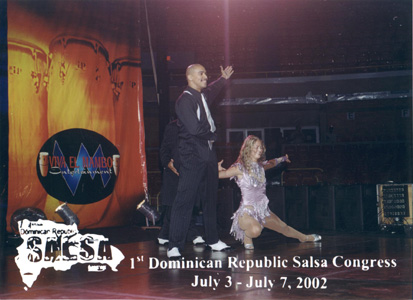 SNY:
How long have you been teaching mambo and what made you decide to teach
mambo? SNY:
How long have you been teaching mambo and what made you decide to teach
mambo?
BM: Compared to others, Ive
only been teaching mambo for a short period of time.
I would love to expand in this area of my dancing career because I love
to help people who want to learn this form of dancing.
I remember how I felt when I was first starting out, and I can see the
same determination in the eyes of other dancers when they are learning their
first mambo steps! I
originally taught ballet to young children in Westchester for a couple of
years, and I really enjoyed it. Teaching
any form of dance really gives you the opportunity to master that form of
dance as well.... when students ask you questions, you think of details that
you may have passed over before, and you really improve as a dancer yourself.
SNY:
What do you like most about teaching?
BM:
I
think the best part of teaching someone is when you see a student improve
right before your eyes.
Some students are insecure and dont think that they will ever
get a move or concept, and when the finally succeed, you get this
amazing sense of accomplishment as a teacher.
Another
benefit about teaching is that you always learn more about what youre
teaching while you are explaining it to a group of people.
You become the master of that shine or technique!!
Sometimes
a student will ask a question that you never would have thought of, and as
youre explaining the technique in detail you think to yourself wow,
thats a good point! I should try that some time.! No, but seriously, it
is an excellent learning experience for both the student and the teacher.
SNY:
Why do you think people come to learn from you?
BM:
When I went to DC to teach a ladies styling/spinning workshop, a lot of
people came simply because I was a female on 2" dancer from New York
City, and a member of the Addie-tude Dance
Company!!! I know in DC there
really isnt an abundance of on 2 classes, so I took advantage of the
opportunity that awaited me!
SNY:
What is the hardest thing you find about teaching?
BM: I
think the most frustrating part of teaching is when you are teaching a large
group of students and half of them are picking up really fast, and the other
half is totally lost.
Its hard to please everyone, but you have to really get a feel for
the overall level of a group.
Its always important to give each person individual attention, and
to make sure that no one feels frustrated or incompetent. You dont want to
intimidate people who are not very advanced and need a lot of repetition, and
you dont want to slow down the people who are looking to learn more.
I also find it challenging when a student is not very determined and
gives up easily. its hard to get some people to come out of their
shells and just dance!
One of the most common questions Ive heard from beginners is.. How
long is it going to take for me to get really good at this?
The answer to this question totally depends on the student and how
determined they truly are.
If a student only comes to class once a week, theyre not going to
improve that quickly.
Its important to practice at home in front of a mirror, and to go
out to clubs and social dance!!!
I hate to discourage new students, but if they dont dedicate the
time, theyre really not going to notice fast improvement.
SNY:
Do you still like to go to clubs and dance socially?
BM:
Of
course!! I love to social dance.. The only thing that prevents me from social
dancing more often is lack of time!!!! Its hard to balance rehearsals, and
work etc....
I
really enjoy dancing at clubs and social events where there are good on
2" dancers, or better yet, to go out with a group of people that I enjoy
dancing with, that always ends up being a great time out.... and a late
night!! When
I first started taking classes at Dance Manhattan, I made friends with a group
of students there who I used to go out social dancing with all the time.
It was the best, we would go to class, and then go out to the Copa or
Latin Quarters right after class and practice what we had just learned! Those
were the days!! One
of the best feelings when you go out social dancing is when a complete
stranger approaches you and compliments your dancing, and theyre really
sincere about it.
It really gives you a great sense of accomplishment... I always think
back to when I used to stand on the sidelines and watch someone dance... I
would always approach them and tell them how much I admired their dancing.
Its even a greater sense of accomplishment then hearing an audience
applaud for you... sometimes I get the feeling that applause is obligatory
during a performance.
When someone goes out of their way to tell you how much they enjoy
watching you dance... that is a genuine expression of their
appreciation.
SNY:
How about performing? Do you still perform and whom have you performed
for
or with?
BM: Yes,
I currently perform with the Addie-Tude Dance
Company.
I love to perform.. It is the best feeling when you can share your
performances with your friends and family.
Performing is truly the best way to express yourself as a dancer, and
to showcase all of your hard work and training!
SNY:
Name your favorite on stage performance?
BM:
My
favorite on stage performance, in terms of actually performing a number would
have to be "Muncea"
with Addie-Tude.
It is really a challenging number to perform, but it is very theatrical
and involves many different styles of choreography, so it is a lot of fun...
plus I get to wear wings on my back!!!
SNY:
What got you into performing and what was your first time on stage?
BM:
I
first began performing Ballet on stage at the age of 4 years old!! (Not that I
remember much from my first performance!!) But I always enjoyed the thrill of
learning choreography and performing as a child, and continued to perform in
annual ballet recitals until I was 19 years old.
My first Mambo performance was at Dance Manhattan, and it was a small
group of students who performed a short choreography (by Eleanor Lopez) at the
Christmas showcase/guest night.
It was a little nerve wracking, but we did a good job.
It was a great feeling to perform in front of a large audience again..
it made me realize how much I loved performing.
SNY:
What did you feel when you first performed live on stage?
BM: I
think that I still get that same feeling every time I perform live on stage...
its that bittersweet feeling of nervous excitement.
I always loved that! (And still do!)
I always feel kind of relieved after a successful performance, but at
the same time I am a little melancholy because all the anticipation and hard
work is gone after such a short performance!
I immediately begin looking forward to my next scheduled performance!
SNY:
What is it that you like about traveling to teach?
BM:
I
really enjoyed meeting new people and getting the feel of the mambo scene in
another major U.S. city.
Most of the students came to the workshop with little information about
me, just the urge to meet a new instructor and see what I had to offer them.
It was a very successful weekend.
SNY:
What is the difference between teaching a regular class and special
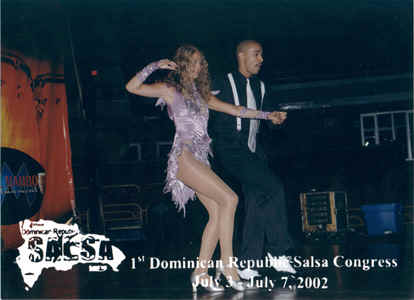 one-shot
workshop/seminar? one-shot
workshop/seminar?
BM: I
have assisted Addie Diaz in her classes a few times and taught a few private
lessons and taught a few gig type group classes, but in comparison to
the workshop I taught, it is a lot more pressure when teaching a workshop
because people are expecting to get more out of a workshop.
Most workshops focus on a certain aspect of dancing, and are usually
longer than the average class.
You can also be more specific when teaching a workshop... regarding the
level of the workshop and what form of dancing you will focus on. I also think
that there is more detailed preparation involved in orchestrating a successful
workshop.
SNY:
Which gives you the best joy? Teaching, performing or putting together
choreography?
BM: Performing
is my passion, but I also enjoy teaching, because you are sharing your
knowledge and patience to others who want reach that same level of dancing
that you are on.
I feel like its your duty as an advanced dancer to offer your
expertise to beginner students because once upon a time everyone was a
beginner and you have become the dancer you are because someone took the time
out to help train and perfect you as a dancer, so why not return that same
favor to the next generation?
SNY:
How is it that you prepare yourself for a workshop? and for a
performance?
BM:
Preparation
for a performance is a little bit easier because there is a set choreography
that just requires repetition and perfection.
When I am learning a new choreography, one of the best exercises to
memorize the steps is to write down the sequence and keep repeating it in your
mind. I
used to do this with new shines or turn patterns that I would learn in a
class. After
writing down the choreography, you can go over it while riding the train,
before you go to sleep, wherever!! Just as long as you keep repeating the
sequence of the choreography in your mind the rest will come naturally.
Then of course, when you have the time (and the space) you have to
practice as much as you can!
I have been guilty of practicing in the conference rooms at my job when
I really need to memorize a new step!!!!!
Preparing
for a workshop requires more time and thought.
You have to almost choreograph what you are going to teach and make
certain that you know that choreography backwards and forwards before you
attempt to break it down to a room full of people!!! When I taught the
workshop in DC I first consulted with Addie Diaz and got a lot of little tips
and pointers on teaching a successful workshop.
I typed up a list of shines that I was teaching, and gave copies to all
of the students.
I also prepared a detailed list of techniques that I went over with the
class while teaching them. This way the students have something to take home
with them that always works better then trying to remember what you learned a
week later!!
SNY:
What advice would you give those just getting into mambo? How can they
work
at getting
better
at dancing?
BM: For
those who are just getting into mambo, congratulations! You have made the
decision to commit to learning something that sparks your interest.
Some people take mambo classes for a small part-time hobby, and others
have that burning desire to be the best that they can be.
You have to remember that in order to reach your goals, you really have
to work hard, be focused and dedicate a reasonable amount of time to your
endeavors. This
advice goes with anything you are attempting to learn.
If you go to class once a week and never social dance or practice at
home, its going to take you triple the amount of time to really learn to
dance than it takes the person who goes to two classes a week, and social
dances regularly and practices at home.
If you dont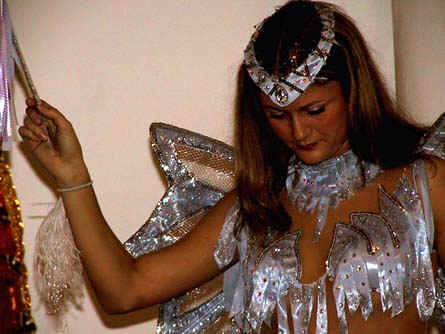 really love dancing, and dont have that burning
desire to improve, then you are not ready to take on the challenge of becoming
an excellent dancer.
Always be open to criticism, and realize that even your instructor was
once in your beginner shoes!!!
Thats why I dont understand the egos that some dancers develop as
they become professional dancers... no one became the dancer they are by some
sort of divine intervention!!! I mean, everyone took their first basic steps
and struggled to learn the most basic shines at some point in their dancing
career!! Who are they kidding????!!!!!
Although some people may pick up faster than others, or have a
natural talent for dancing, there is no need to ever be cocky or have a
know it all attitude! really love dancing, and dont have that burning
desire to improve, then you are not ready to take on the challenge of becoming
an excellent dancer.
Always be open to criticism, and realize that even your instructor was
once in your beginner shoes!!!
Thats why I dont understand the egos that some dancers develop as
they become professional dancers... no one became the dancer they are by some
sort of divine intervention!!! I mean, everyone took their first basic steps
and struggled to learn the most basic shines at some point in their dancing
career!! Who are they kidding????!!!!!
Although some people may pick up faster than others, or have a
natural talent for dancing, there is no need to ever be cocky or have a
know it all attitude!
One
of my favorite Dancing quotes is the following:
GREAT
DANCERS ARE NOT GREAT BECAUSE OF THEIR TECHNIQUE, THEY ARE GREAT BECAUSE OF
THEIR PASSION" --MARTHA GRAHAM
SNY:
How best could you describe your way of dancing? of teaching? and of
performing?
BM:
Hmmmm,
lets see, its always fun to analyze yourself without being critical,
cocky or too modest... ha ha
Dancing:
I would describe my way of dancing as sexy but with class and
style... you dont want to over do it!!! Whenever I social dance, I always
try to smile and let the world know that right now... at this very moment, I
am doing what I love to do, Im experiencing my passion, and no one can ever
take that away from me.
Teaching:
I love to teach and I will always offer any student of mine patience and
understanding, especially if they are willing to work hard and be focused, I
will give my all to try and improve someone as a dancer, and I will never
doubt the potential of anyone.
Performing:
In regards to performing, I have the same point of view as social dancing HAVE
A GOOD TIME... and let it show! I always make a point to SMILE!!!!
Even
if your feet are killing you, your costume is too tight, and the crowd is
difficult or intimidating... if you can convey a sense of happiness to the
audience... even if its fabricated.. you will be someone that everyone
loves to see perform.
SNY:
How is New York Mambo Dancing different from mambo dancing in other
parts
of the country?
BM:
I think the advantage that New York has over other parts of the country is the
fact that our city is one of the most populated cities in the country, so we
totally benefit by having such an immense mambo community.
When you visit other cities, there are usually only one or two clubs
that play a good deal of salsa, and entertain a small group of quality
dancers. Mambo dancing doesnt only exist in Manhattan, you can find
great mambo clubs and dancers in all of the 5 boroughs of New York and in
Westchester County, New Jersey and Connecticut.
So our options are abundant with a wide variety of venues in which we
can enjoy mambo dancing.
The
dancing in New York has a lot of flavor and passion that I dont seem to
find in other parts of the country.
I guess it is the direct product of a city that is a true melting pot
of cultures and history.
SNY:
Do you think that dancers get treated with respect? If not why?
BM:
think that for the most part, dancers are well respected within any true
dancing community.
Fellow dancers will always respect and praise the hard work of any
dancer, no matter what form of dance they are pursuing.
But in the business world of dancing, it is more difficult to achieve a
genuine level of respect from your peers or clients because they have no idea
how much work and time is invested in preparing for a performance.
For example, when most people want to hire dancers, they may think that
$150 is a huge price to pay per dancer when they are only putting on a 15
minute show, but they fail to recognize the fact that the dancers have been
investing hours and weeks of rehearsals and costume fittings for a mere 15
minute show.
This is where the dancers are not given the level of respect that they
deserve. I
guess it truly depends on the venue and people you are dealing with.
Sometimes dancers are treated like stars, and other times they are
treated as the hired help.
SNY:
What would you like to see happen to mambo within the next few years?,
next
decade? within
your
lifetime?
BM:
In
the next few years, I hope that Mambo continues to grow and remains
a dance form
that is enjoyed by millions of people.
I think that in the last few years Mambo has really taken off
with the whole Latin explosion crossover in the general public.
I hope that Mambo and Latin culture as a whole continue to be
recognized and sought after by inquiring minds.
In the next decade it would be ideal if Mambo dancing became as
common as any other form of dance with a growth of dance classes and schools,
nightclubs, and on Broadway!!!
Within
my lifetime, I expect to continue to be an active mambo dancer for as long as
my feet will allow it!! I just hope that mambo will continue to be around long
enough for my children and grandchildren to enjoy it!
I think that future generations will keep the legend of Mambo alive and
that it will be around for a while!
SNY:
What is the best way for someone interested in learning mambo can get in
contact with you?
Click here for
Brett's current contact info.
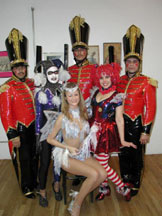
Brett (center) as the fairy
in the Addie-tude Dance Company's
Muneca dance number.
Photo courtesy of Mambon2.com
[Main
Menu ] [Magazine
Home ] [New
Articles this month ] [Instructors
] [NY Dance News]
[Articles]
[Submit
an Article] [Calendar
of Dance Events]
Best Viewed In Internet Explorer
|


![]()